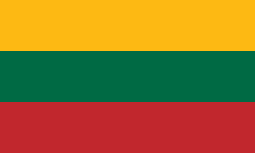 | |
| Use | National flag and civil ensign |
|---|---|
| Proportion | 3:5 |
| Adopted | 25 April 1918 (first adoption) 18 November 1988 (restored in 1:2 ratio) 8 July 2004 (current version) |
| Design | A horizontal triband of yellow, green and red |
| Designed by | |
 State flag of Lithuania | |
| Use | Naval jack and historical state flag |
| Proportion | 3:5 |
| Adopted | 2004; first documented use in 1410 |
| Design | A red flag with the Vytis on the center |
The national flag of Lithuania (Lithuanian: Lietuvos vėliava) consists of a horizontal tricolour of yellow, green, and red. It was adopted on 25 April 1918 during Lithuania's first period of independence (1918–1940), which ceased with the occupation first by the Soviet Union, and then by Nazi Germany (1941–1944). During the post-World War II Soviet occupation, from 1945 until 1988, the Flag of the Lithuanian SSR consisted first of a generic red Soviet flag with the name of the republic, in 1953 that was changed to the red flag with white and green bands at the bottom.
The flag was then re-adopted on 18 November 1988, about 1.5 years before the re-establishment of Lithuania's independence and almost three years before the collapse of the Soviet Union. The last alteration to the current flag occurred in 2004, when the aspect ratio changed from 1:2 to 3:5.